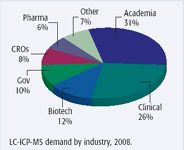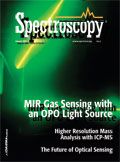Article
Spectroscopy
Spectroscopy
Market Profile: LC-ICP-MS
The coupling of HPLC with ICP-MS is a relatively new technique that combines two very well established analytical methods. The combination of these analytical methods provides what could prove to be a very useful technique in clinical analysis. The total LC-ICP-MS market amounts to only a few percent of the overall ICP-MS market, but it is rapidly developing into a significant niche market.
The coupling of HPLC with ICP-MS is a relatively new technique that combines two very well established analytical methods. The combination of these analytical methods provides what could prove to be a very useful technique in clinical analysis. The total LC-ICP-MS market amounts to only a few percent of the overall ICP-MS market, but it is rapidly developing into a significant niche market.

LC-ICP-MS demand by industry, 2008.
LC-ICP-MS is proving to be useful for the speciation and quantitation of those species in relatively complex matrices, such as those in biology. The connection of HPLC instruments to ICP-MS systems is relatively simple, and does not require an extensive amount of additional hardware or service to perform. This fact allows laboratories that already have both HPLC and ICP-MS to utilize the technique easily.
LC-ICP-MS is valuable for evaluating environmental exposure of humans and animals; for detection of various, often very rare, diseases and disorders; and for other clinical analyses. In the long run, this will result in the largest demand coming from clinical analysis laboratories. However, for the time being, academic laboratories, and to a lesser extent government laboratories, are where the action is in exploring the full potential of the technique.
The global market for LC-ICP-MS will be less than $15 million in 2008, but this does not include those ICP-MS and HPLC systems that were installed separately. This market estimate includes only those HPLC and ICP-MS systems specifically installed together, as well as connection kits, software, and service related to all LC-ICP-MS operation. As a relatively new and small segment of the ICP-MS market, LC-ICP-MS demand will easily top 20% annual growth in the near-term as the technique begins to mature.
The foregoing data were based on SDi's market analysis and perspectives report entitled Global Assessment Report, 10th Edition: The Laboratory Life Science and Analytical Instrument Industry, September 2008. For more information, contact Stuart Press, Vice President — Strategic Analysis, Strategic Directions International, Inc., 6242 Westchester Parkway, Suite 100, Los Angeles, CA 90045, (310) 641-4982, fax: (310) 641-8851, www.strategic-directions.com.
Newsletter
Get essential updates on the latest spectroscopy technologies, regulatory standards, and best practices—subscribe today to Spectroscopy.






